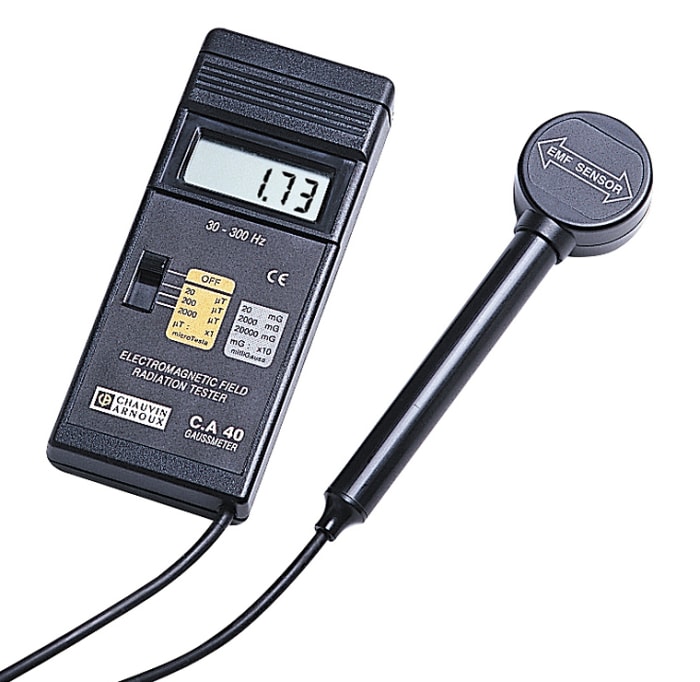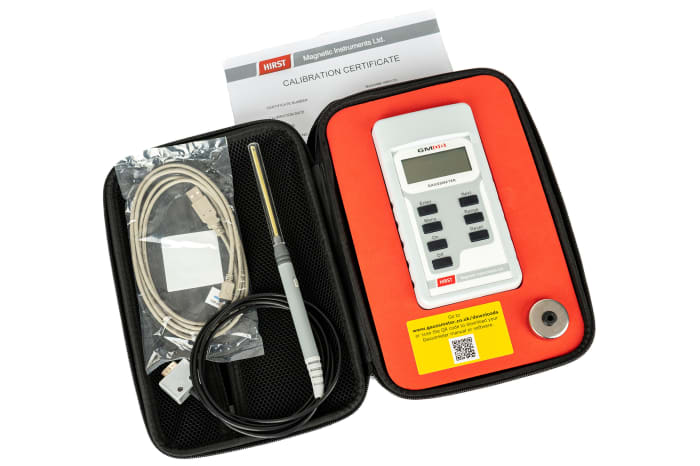Hirst Magnetics GM07 Gauss Meter, DC and 15 Hz → 10 kHz
Technical Document
Specifications
Brand
Hirst MagneticsMagnetic Range
0 → 2.999 mT, 0 → 29.99 mT, 0 → 299.9 mT, 0 → 3 T
Maximum Magnetic Measurement
2.999 mT, 3 T, 29.99 mT, 299.9 mT
Minimum Magnetic Measurement
0 mT, 0 T
Best Accuracy
±1 %
Frequency Range
DC and 15 Hz → 10 kHz
Operating Units
Amps/m, Gauss, Oersteds, Tesla
Maximum Operating Temperature
+50°C
Minimum Operating Temperature
0°C
Battery Type
AA
Power Source
Battery
Width
89mm
Length
175mm
Dimensions
175 x 89 x 40mm
Height
40mm
Model Number p
GM07
Weight
430g
Country of Origin
United Kingdom
Product details
Hirst Magnetics GM07 & GM08 Gauss Meters
For measurement of flux density and magnetic field strength of DC,AC and peak magnetic fields in S.I c.g.s units, these two microprocessor-controlled menu-driven instruments are the GM07 & GM08 series. Featuring graphical monochrome LCD display, probe polarity indicator and operating function and units display, it offers a sleek, lightweight and robust design. Complete with a thin semi-flexible probe, it is the ideal instrument for factory floors, on site and laboratory applications.
Hirst Magnetics instruments GM07 and GM08 offer sophisticated measuring functions in a simple use, menu driven, hand held package.
Features and Benefits:
Battery operated
Multi-lingual
Compatible with transverse and axial probes
Retains measurements when powered down
0°C to +50°C operating temperature
Accuracy is specified, at 20°C +/- 1%
Calibration Certificate included
USB and RS232 connections allow control from PC and easy upload of data
Analogue output BNC compatible(Only on GM08)
External power connection also available
How Does a Gauss Meter Work?
Gaussmeters are a Hall probe, a test current is sent by the meter through the probe. This Hall affect produces a voltage and the meter then records this. Often the highest voltage detected is used or frozen by the meter as voltage fluctuation is common given that magnetic fields are rarely static.
Did you know?
Carl Friederich Gauss born in 1777 developed one of the first devices that could measure direction and strength of a magnetic field. He was a pioneer in this type of study and a great mathematician. He created the system used to measure magnetism and is the reason the modern unit of flux density is named Gauss and why we call these units Gauss meters.
₹ 145,769.69
₹ 145,769.69 Each (Exc. GST)
₹ 172,008.23
₹ 172,008.23 Each (inc. GST)
1
RS Components & Controls (I) Ltd
Distribution hub - B-89, Sector 67, Noida, Gautam Budh Nagar, (Uttar Pradesh), 201 301
₹ 145,769.69
₹ 145,769.69 Each (Exc. GST)
₹ 172,008.23
₹ 172,008.23 Each (inc. GST)
Stock information temporarily unavailable.
1
Stock information temporarily unavailable.
Technical Document
Specifications
Brand
Hirst MagneticsMagnetic Range
0 → 2.999 mT, 0 → 29.99 mT, 0 → 299.9 mT, 0 → 3 T
Maximum Magnetic Measurement
2.999 mT, 3 T, 29.99 mT, 299.9 mT
Minimum Magnetic Measurement
0 mT, 0 T
Best Accuracy
±1 %
Frequency Range
DC and 15 Hz → 10 kHz
Operating Units
Amps/m, Gauss, Oersteds, Tesla
Maximum Operating Temperature
+50°C
Minimum Operating Temperature
0°C
Battery Type
AA
Power Source
Battery
Width
89mm
Length
175mm
Dimensions
175 x 89 x 40mm
Height
40mm
Model Number p
GM07
Weight
430g
Country of Origin
United Kingdom
Product details
Hirst Magnetics GM07 & GM08 Gauss Meters
For measurement of flux density and magnetic field strength of DC,AC and peak magnetic fields in S.I c.g.s units, these two microprocessor-controlled menu-driven instruments are the GM07 & GM08 series. Featuring graphical monochrome LCD display, probe polarity indicator and operating function and units display, it offers a sleek, lightweight and robust design. Complete with a thin semi-flexible probe, it is the ideal instrument for factory floors, on site and laboratory applications.
Hirst Magnetics instruments GM07 and GM08 offer sophisticated measuring functions in a simple use, menu driven, hand held package.
Features and Benefits:
Battery operated
Multi-lingual
Compatible with transverse and axial probes
Retains measurements when powered down
0°C to +50°C operating temperature
Accuracy is specified, at 20°C +/- 1%
Calibration Certificate included
USB and RS232 connections allow control from PC and easy upload of data
Analogue output BNC compatible(Only on GM08)
External power connection also available
How Does a Gauss Meter Work?
Gaussmeters are a Hall probe, a test current is sent by the meter through the probe. This Hall affect produces a voltage and the meter then records this. Often the highest voltage detected is used or frozen by the meter as voltage fluctuation is common given that magnetic fields are rarely static.
Did you know?
Carl Friederich Gauss born in 1777 developed one of the first devices that could measure direction and strength of a magnetic field. He was a pioneer in this type of study and a great mathematician. He created the system used to measure magnetism and is the reason the modern unit of flux density is named Gauss and why we call these units Gauss meters.


